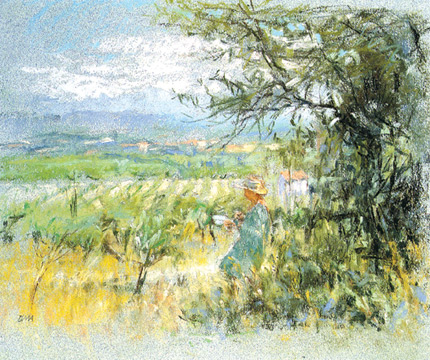Creating a self-portrait thru related medium
by Tissa Hewavitarane
I intend to demonstrate the techniques of portraiture through the art
of the self-portrait. I primarily concentrate on watercolour my
favourite medium, but intend to introduce a series of work through
related media such as pencils, ink, chalks and pastels.
Creating a self-portrait begins with a short introduction looking at
the history of it and the work of some of the world's most famous
artists.
Artists always reflect themselves in their paintings if not in
self-portraits, then in the mood and colour schemes of their work. This
series of articles is dedicated to all artists, and amateurs and to the
art of self-portrait.
For millions, self-portraits have been of great interest to viewers
and painters alike. For the spectator, they can provide a marvellous
insight into the character of artists and also into their art itself, as
the work of old masters, such as Rembrandt, William Bowyer and Graham
Sutherland in 1903.
Life
For artists, the attraction of the self-portrait includes the fact
that it enables them to paint from life without hiring a model or being
limited by time other than their own. In a studio, if an artist hasn't
got a sitter, he will either paint a still life or a self-portrait.
Self-portrature is also the best way of learning how to depict the human
face and in a range of media and styles.
|

Diana Armfield's self-portrait in a landscape in pastel. |
What I feel most strongly about in self-portraiture is that the
artist must be honest in his vision. Only by being objective will you
understand how to depict yourself. This will also enable you, later to
paint the portraits of other people convincingly.
History
Self-portraiture has existed at least since the ancient Egyptians,
when a few artists in the middle of the second millennium BC were
sculpting narrative reliefs on tomb walls and adding their
self-portraits to the carvings some of which were later painted.
Much later, Roman artists were painting portraits on to wood panels,
canvas and walls. Although no identifiable self-portraits remain,
undoubtedly some were painted. During the European Dark Ages, the light
of culture was shining bright in the East. In China, Wang Hsi-Chi, a
calligrapher, is documented as having painted his portrait with the aid
of a mirror.
But secular paintings were frequently destroyed by succeeding
dynasties and unfortunately the self-portrait no longer exists. However,
later self-portraits are extant, many of them painted in watercolour,
ink and wash.
Manuscripts
The earliest traceable two dimensional self-portraits in Europe are
illuminated manuscripts. Painters soon found another means of
introducing themselves into their work. In their images of St Luke
painting the Virgin, artists frequently depicted themselves St Luke,
their patron saint. One of the first painters known to do this was the
Netherlandish artist Rogier Vander Weyden. Other artists were
incorporating their images into paintings of a more secular nature. In
the 16th century mirrors were first made from glass backed with a
mercury. This gave a better reflection than the metal mirrors that had
been used until then.
At the same time, there was a greater appreciation of the creative
powers of artists, which coincided with a widespread cult of the ego and
glorification of the individual.
Perhaps because of these factors, artists were more aware of
themselves than before and that period saw a rapid increase in the
amount of self-portraits produced. It is surprising that the two of the
most prolific Renaissance artists, Leonado da Vinci (1452-1519) and
Michelangelo (1475-1564) have left us with very little.
Michelangelo left only two identifiable self-portraits, one of which
is quite startling. It is the scene of the "Last Judgment, on the altar
wall of the Sistine Chapel.
At the same time Michelangelo produced a paint of his reflection in a
convex mirror in 1525 and used it to promote himself as an artist.
It was not until Rembrandt Harmensz Van Rign (1606-69) that self-portrature
really became an art form in its own right.
Women artists
After Rembrandt, almost every successful artist painted a
self-portrait. In Spain, Velazquez (1509-1660) painted Las Menin as
showing himself at work at an easel.
One of the few women artists of the time, Marie-Antoinette's
favourite portraitist, Elisabeth Vigee-Lebrun (1755-1842) was also
producing self-portraits. In England there were no great English-born
portrait painters until the 1740s.
Sir Peter Lely a court painter of Netherlandish origin painted formal
self-portraits. Later artists such as William Hogarth painted relaxed,
almost unflattering self-portraits.
In North America, the first generation of American born portrait
painters were working at this time. They included Robert Feke
(1705-1750) and Gilbert Stuart (1755-1828) whose self-portraits were in
the tradition of the English painters.
In the 19th century, self-portraits became increasingly subjective.
The advent of the camera furthered this trend and also enabled artists
to see not a mirror image, but now they looked to others.
Every artist has his own way of analysing the self-image and
expressing individuality.
Observe the landscape shown here. Its a self-portrait in a landscape
done in pastel. A self-portrait does not have to be done in a studio,
staring at your reflection in a mirror. You can do it almost anywhere as
this lovely pastel done by Diana Armsfield shows. She has used a tree in
the image, with her skirt blowing.
There is a good sense of the movement of the wind. The whole image is
held together by the L-shape. |

